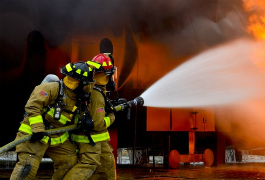Spotlights
Fireman, Municipal Firefighters, Fire Engineer, Fire Equipment Operator, Fire Fighter, Fire Management Specialist, Fire Technician (Fire Tech), Firefighter, Forest Fire Suppression Specialist, Forestry Fire Technician (Forestry Fire Tech), Hot Shot, Wildland Firefighter
Firefighters perform rescue and firefighting operations to include fires, vehicle accidents, and natural disasters.
- Helping and saving others!
- Good pay and job security
- The rush!
- Work schedule: Might work 24-hour shift, then have 48 to 74 hours off or work 48-hour shift, then 96 hours off, due to the rigor of the job. With the time off, they have time to recuperate, take on side jobs which can supplement their income.
- Good retirement
“Volunteers make up 70% of the nation’s fire service. The fact that people are willing to do the job for free speaks for itself.” Jonathan Yi, Firefighter, Beaumont Fire Rescue
Note: Varies from station to station.
- 0700-0730: Arrive to station. Receive incoming report from the person you’re relieving. Check equipment.
- 0800: Official shift change.
- 0800-0830: Breakfast
- 0830: Station duties
- 0900-1200: Training: May include fire fighting techniques, medical knowledge and skills, hazardous materials, specialized rescue training, or management training.
- 1200-1300: Lunch
- 1300-1700: Training/Workout
- 1800-1900: Dinner
- 2000: Make bed
- 2100: Official time you can sleep
- 0700: Wake up tones. Clean the station. Clean apparatus. Give out going report of the day to your relief.
Calls
The above schedule does not include the average 10-20 calls per day that are split between the fire stations in the area. The time spent on a call can vary from 30 minutes to several hours or more and may involve one or two engines or every piece of available apparatus. This can have a significant impact on the schedule for the day and many times training or maintenance must be rescheduled to another day.
- Emergency medical treatment
- Firefighting
- Understanding of fire protection systems, apparatus, equipment operations & maintenance
- Public relations
- Determination: Takes years until you get the job and hundreds of hours of training
- Self-reliance:
- Bravery/courage
- Physical aptitude
- Awareness
- Work well with a team
- Good under pressure
- Listening skills
- Resourcefulness
- Initiative
- Drives fire trucks and other emergency vehicles to emergencies.
- Puts out fires using hoses and pumps.
- Finds and rescues victims in burning buildings or in other emergency conditions.
- Treats victims’ injuries with emergency medical services.
- Prepares written reports on fire or emergency incidents.
- Cleans and maintains equipment.
- Conducts drills and training in fire fighting techniques.
- Provides public education on fire safety.
- Dangerous and life-threatening
- Physically and mentally demanding: The fire service is a paramilitary type organization. If you have issues with following orders or lack any type of initiative, this job is not for you.
- Long hours when on call
- Highly competitive to enter into industry and a lot of testing
“As most career guys stay for 20 plus years, the turnover rate is low. I've tested with 7-8 departments before landing a spot but most of the time you’re competing with hundreds and thousands of guys testing for the same spots, sometimes a single opening. Once you do make it on a written list, you're competing again to secure a spot with physical agility testing, psychological testing, lie detector and multiple interviews. Once you make it, the testing isn't over. Most departments require 12-18 months of probation where you go through phase testing and basically prove your worth.” Jonathan Yi, Firefighter, Beaumont Fire Rescue
- Liked the outdoors!
- Liked adrenaline-filled activities!
- Enjoyed helping people.
- Firefighters don’t need a college degree but must be 18 years old and have a high school diploma or GED, plus some training in emergency medical services
- Per the U.S. Fire Administration’s Fire and Emergency Services Higher Education Project, students may get a head start by taking relevant community college or vocational training courses in “building construction for fire protection, fire behavior and combustion, fire prevention, fire protection systems, principles of emergency services, principles of fire and emergency services safety and survival”
- Many students earn a 60-credit associate’s in fire science to boost their credentials
- Candidates must pass various tests prior to acceptance into a formal fire academy training program
- Fire academy training may take 12-14 weeks and covers topics such as “firefighting, fire-prevention techniques, local building codes, emergency medical procedures” as well as “how to fight fires with standard equipment, including axes, chain saws, fire extinguishers, and ladders”
- The pre-acceptance testing process generally includes a background check and interview plus:
- The general written exam covering:
- Mathematical reasoning
- Mechanical reasoning
- Reading comprehension
- Spatial orientation
- Situational judgment
- Observation and memory
- Personality
- Physical fitness test (usually either the Candidate Physical Ability Test (CPAT) or BIDDLE physical ability test)
- Medical and psychological screening
- The general written exam covering:
- Some departments may require candidates to have obtained emergency medical technician (EMT) or paramedic certification
- Applicants must hold a valid driver’s license. Those who operate a fire truck will need a commercial driver’s license (CDL) or firefighter endorsement on their standard license
- Wildland Firefighters will complete the Forest Service’s apprenticeship covering 3,000 hours of On-the-Job training, including a two-month residency at California’s Wildland Fire Training Center
- Once hired, Firefighters are subject to random drug testing. They may attend ongoing training via state and local agencies plus federal training sessions conducted by the National Fire Academy
- If your high school has an EMS/EMT program, take it.
- Talk to your local firefighter and see if it is something you would like.
- Map out your career goals and research the exact requirements to be a Firefighter in the community where you want to work. Different locations have different requirements!
- High school students can prepare by taking classes in health and medicine, first aid, safety, physical education, driver’s education, math, chemistry, building construction, architecture, and communications
- If possible, sign up to take Firefighter community college courses like “building construction for fire protection, and fire behavior and combustion”
- Consider doing an associate’s degree in fire science. Decide if in-person, online, or hybrid learning is best for your needs
- Knock out your emergency medical technician (EMT) or paramedic certification
- Volunteer as a junior Firefighter to “learn about local fire, rescue, and emergency medical services response organizations”
- Ask a school counselor about other work or volunteer opportunities where you can pick up real-world skills. Community involvement also looks great on an application. Consider helping the American Red Cross or Habitat for Humanity
- Commit to a diligent exercise schedule so you can pass the Candidate Physical Ability Test (CPAT) or BIDDLE physical ability test. Review the criteria and adjust your workouts to help you prepare
- Note, the fitness tests measure not only your ability to perform tasks, but also how fast you do them
- Be mindful of the required background checks. Stay out of trouble, maintain a good credit score, and keep your social media accounts professional
- Study for the Firefighter written exam, but note that different states may feature different tests. Check with your local firefighter department to ensure you know which test you’ll be taking
- There is a ton of study materials available, from books to online quizzes. Just make sure you study for the right test and use up-to-date materials!
- 20% with HSDiploma
- 19% with Associate's
- 16.2% with Bachelor's
- 1.5% with Master's
- 0.5% with Doctoral

- Build connections during volunteer work to gain valuable references
- Study hard for the written exam, be physically fit for the fitness exam, and have your affairs in order for the background check
- If you take college classes, work with your school’s career center to find jobs, polish your resume, and practice interviewing
- Talk to local departments about openings and sign up for job alerts on Indeed, Glassdoor, and other job portals
- Review job ads carefully and ensure you meet all listed requirements. If needed, go back and beef up your credentials before applying
- Try to get your EMT or paramedic certification beforehand to be competitive
- Consider being a volunteer junior Firefighter to gain practical experience
- Move to where the jobs are! The Bureau of Labor Statistics notes that the states with the highest employment levels of Firefighters are Texas, California, Florida, Ohio, and North Carolina
- You may not need a resume at first, but it can’t hurt to review Firefighter resume templates for ideas
- Ask potential references in advance before giving out their contact info
- Must fulfill requirements for your testing department. Requirements vary per state.
- Pass written entry exams and being able to pass physical agility tests. You want to score high enough to make the list. The size of the lists usually varies depending on the department that is hiring. Placing top 10 is preferred.
- Interviews (~typically 4, Sometimes multiple board interviews)
- Board Interview: Present yourself in front of a panel of 6-12. Includes various personnel from the department (chief, captain, firefighters, civilian staff). Questions range from job capabilities to personal worth. Stay calm and answer all questions in a clear way.
- Polygraph Interview: They look mainly for moral turpitude, honesty and integrity. Lying, stealing, and drug use are usually what they focus on.
- Fire Chief’s interview: Will make you or break you. There is no telling what they might ask. Chiefs has the ultimately say on whether you get in or not. Approval of City Manager.
- Note: Even though you pass the written exam, physical agility test and board interview, you might be on a waiting eligibility list for awhile.
- Understand that if they’ve done a background check, they may ask questions regarding any items of concern listed on your personal history
- Be honest and ready to answer tough questions, if needed
- Remember — if you made it to the interview stage, odds are the background check did not disqualify you…so don’t let your answers disqualify you, either!
Websites
- Fire Department Safety Officers Association
- International Association of Fire Fighters
- International Association of Women in Fire & Emergency Services
- National Association for Search and Rescue
- National Fire Academy
- National Fire Protection Association
- National Registry of Emergency Medical Technicians
- National Wildfire Coordinating Group
- U.S. Coast Guard National Maritime Center
- U.S. Fire Administration
- U.S. Forest Service
- Wildland Firefighter Apprenticeship
- Wildland Fire Training Center
- World Safety Organization
Books
- Firefighter Functional Fitness: The Essential Guide to Optimal Firefighter Performance and Longevity, by Dan Kerrigan, Jim Moss , et al.
- Firefighter Success: 20 C's to Firefighter Excellence, by Jim Moss, Dan Kerrigan, et al.
- Mastering the Firefighter Exam: The Proven Path from Applicant to Top Spot on the Hiring List, by Steve Cunningham
“No guts, no glory… you are competing with hundreds and thousands of men and women. The real question is how bad do you want it. Do your job, don’t be lazy, keep your mouth shut, have initiative, and ultimately be an information sponge.” Jonathan Yi, Firefighter
"The final test of a leader is that he leaves behind in other men the conviction and the will to carry on." Walter Lippman
Newsfeed

Featured Jobs

Online Courses and Tools









